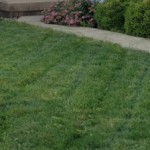 The drought conditions in many parts of the country these past few years have left homeowners with some work to to to bring their lawns back to a lush green state. Early spring and late summer are the best times to work on revitalizing the lawn. Before beginning the needed steps, survey your lawn to determine how bad the situation is. If you only have a few bad areas, these can be handled individually by digging up the dead grass, adding some topsoil, and then planting grass seed in the area. If your whole lawn could use help, here are recommended steps to follow.
The drought conditions in many parts of the country these past few years have left homeowners with some work to to to bring their lawns back to a lush green state. Early spring and late summer are the best times to work on revitalizing the lawn. Before beginning the needed steps, survey your lawn to determine how bad the situation is. If you only have a few bad areas, these can be handled individually by digging up the dead grass, adding some topsoil, and then planting grass seed in the area. If your whole lawn could use help, here are recommended steps to follow.
Before you begin working on rejuvinating your lawn, there is one important thing NOT to do. Do not apply any crabgrass preventer. Crabgrass preventers prevent the crabgrass seed from germinating. Unfortunately, it will also prevent the real grass seed from germinating. So, if you have done this in the spring, then wait until late summer before working on rebuilding your lawn.
Aerate the Lawn
The first step to rebuilding your lawn is core aeration. This step loosens up the soil and gives the grass roots room to grow by extracting small cores of soil and grass and depositing them on the surface of the lawn.
Over Seed the Lawn
Purchase some high-quality grass seed that is appropriate for the amount of sun or shade your lawn receives and, using a lawn fertilizer spreader, spread the seed over the lawn. Some of the seeds will fall into the holes left by aerating and will start growing there. For better results, after over seeding, use the back side of a garden rake and go over the lawn in a raking motion. This will help the seed that is lying on the grass come in better contact with the soil.
Fertilize the Lawn
The next step is to apply a starter fertilizer to the lawn. Starter fertilizers are formulated with extra nutrients to promote growth of the new grass seedlings. Fertilizing the lawn is an important step, so don’t skip it.
Water the Lawn
When applying grass seed, correct lawn watering is very important. New seed requires small amounts of water frequently to germinate and grow. Whereas an established lawn requires larger amounts of water at less frequent intervals. Watering new seed should be done every day unless it rains. Apply enough water to keep the seed from drying out. Once the seed has started to grow and is about a half-inch in height, you can start applying more water at less frequent intervals.
 Hopefully, after following thes lawn rejuvination steps, in about four weeks, your lawn will start looking much better. I healthy, green lawn not only looks nice, but helps keep the weeds from infiltrating. Speaking of weeds, wait until your new grass has been growing for at least six weeks before applying any weed control. You don’t want to kill the delicate grass plants when killing the weeds!
Hopefully, after following thes lawn rejuvination steps, in about four weeks, your lawn will start looking much better. I healthy, green lawn not only looks nice, but helps keep the weeds from infiltrating. Speaking of weeds, wait until your new grass has been growing for at least six weeks before applying any weed control. You don’t want to kill the delicate grass plants when killing the weeds!
No comments yet.